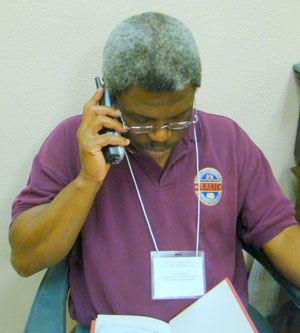 The rate of change in the world today conceivably has never been faster. Many of the old systems applied to growth and development are rapidly changing into new forms too different to be fully understood.
The rate of change in the world today conceivably has never been faster. Many of the old systems applied to growth and development are rapidly changing into new forms too different to be fully understood.
The old pattern of a few countries mining the rest of the world for raw materials and reseeding just enough with goods and services to successfully repeat the cycle has been replaced by something else. Global growth and development are no longer almost solely reliant upon the World Bank, the International Monetary Fund, and one or two other global financial institutions; it now includes significant support from developing countries that once were the countries being mined as a raw material resource.
China is perhaps the indisputable leader of this new growth and development group. According to the Inter-American Dialogue, a non-profit group based in Washington, D C, Chinese banks sent nearly $30 billion in loans to Latin American and the Caribbean last year, more than double the amount from 2014. It's also more money than the World Bank and Inter-American Development Bank gave to the region last year combined.
http://www.thedialogue.org/map_list/
Equally significant, the Inter-American Dialogue also points out, Chinese and IFI/Western banks do not overlap significantly in Latin America [and the Caribbean]. They give different size loans to different sectors in different countries. Chinese loans tend to focus on infrastructure and heavy industry, for example, while Western loans cover a range of government, social, and environmental projects. Chinese banks channel 87 percent of their loans into the energy, mining, infrastructure, transportation, and housing (EMITH) sectors. Only 29 percent of IDB loans and 34 percent of World Bank loans go to EMITH sectors, while more than a third is directed toward health, social, and environment sectors. Chinese banks have indicated that they prefer EMITH loans because they directly support economic growth.
http://ase.tufts.edu/gdae/Pubs/rp/GallagherChineseFinanceLatinAmericaBrief.pdf
These are immense winds of change and they are blowing ever stronger all over the globe and significantly so in Latin America and the Caribbean. Even now, millions of dollars in Chinese investments are being plowed into the island of Antigua and out of this will come world class hotels and other tourism developments affecting the entire region. This is in direct competition to St. Maarten’s tourism market, which makes up 80% of the revenues the country generates. Make no mistake; the Global marketplace is a highly competitive arena and it is relentless in its search for places to grow and develop.
Today, Sint Maarten finds itself in the enviable position of being such a place. The Chinese want to heavily invest in the country. "China Pearl of the Caribbean Project at Belair Beach St.Maarten"...St.Maarten is already considered one of the best destinations in the Caribbean and its face is Tourism...don't cover its face with a towel...
I say, go for it!
On Wednesday, September 07, Prime Minister William Marlin made a calm, clear presentation to various members of the press when he addressed the media at the Council of Minster's press briefing about the negotiations with a Chinese group to construct the Pearl of the Caribbean Resort on St. Maarten. He took special pains to dispel the misinformation, misunderstanding, and fear that some people seemed to possess that their island and their way of life was being taken over by foreign invaders. It is reasonable that there are those who feel varying degrees of unease about the Resort contract and this is almost certainly based not on what they know, but what they don’t know; thus the close questioning and the Prime Minister’s need to address all question forthrightly. This he did!
In matters such as these transparencies is vital and critical to the success of the project. It is to be expected that this course of action will continue to be taken by the Prime Minister and his Government as negotiations continue and the project commences. Nevertheless, the most productive course of action is for St. Maarten is to proceed with the Chinese partnership and then go even further by using this project to seek out even greater partnerships.
Rather than hesitate in doubt and fear St. Maarten should enthusiastically and fully take on the responsibilities for its growth and development. It should dispel the fear of growing up and becoming fully matured; making its own way in the world. As “fear-provoking” as it may be, we all have to grow up and take on the responsibilities of becoming mature individuals, ready to support and build our organizations so that we can create healthy communities and a great country – top down and bottom up. I see talks of independence for St.Maarten the first step is to move towards financial independence increase your GDP.
When presented with such opportunities one has to be ready to capitalize on them. Of course, there is always the need to proceed wisely in these matters, but nonetheless in a world faced with new and ever-expanding challenges, when great opportunities present themselves, one has got to take full advantage of them.
It is no longer viable to look to the Netherlands for funding; indeed, such subsistence and the growing debt it incurs never are the way to go. The Netherlands is a relatively small country with challenges of its own and with diminishing revenues earmarked for countries like St. Maarten; even though St. Maarten is a Constituent Country of the Netherlands. It should be no surprise then that the Netherlands is actively supporting a restructuring of its financial relationships to St. Maarten; encouraging the implementation of systems that promote St. Maarten’s self-sufficiency.
No country wants to be in the unenviable position of having insufficient funds to pay for all the goods and services it needs, having difficulty in its prospects of obtaining those funds and not attracting enough investors.
By now you as individuals may have come to the realization that you are St Maarten and St Maarten is you! And that as you go, so will St. Maarten!
There is no turning back. You cannot afford to and it will not be possible to do so. You now must forge on to build and create a St. Maarten that never existed before. It can be done!
All of St. Maarten has to become involved and create the energy that will produce the power for and of this greater vision. You cannot follow failed governmental policies, yours and those of others, and hope to succeed. The ways in which you educate, train and support the citizens and residents of St Maarten have to evolve to higher standards with much more effective outcomes. This is the only way to build stronger, more sustainable and productive organizations and thus a better St Maarten.
As your Finance Minister recently pointed out: “Our budget every year is under stress and there is no fiscal space to take the necessary steps to combat unemployment, crime, or fix our infrastructural needs, such as weaning ourselves off of fossil fuel imports, food imports, solve our traffic problems, our communication deficiencies, electrical outages, and I can go on and on. What we need are foreign investments to boost our GDP. In the Caribbean, we are at the lowest in attracting foreign investments. In fact, for years we have not been able to attract any major investment until now.”
You are already behind in the investment market, but you can close ground quite quickly because you have tremendous assets that you have yet to fully reveal to the global marketplace.
Again, as the Finance Minister went on to explain: “We now have a breakthrough in attracting a foreign investment that is a behemoth of an investment and a structure and plan to generate travel to Sint Maarten from the entire Caribbean and Latin America for years to come. Besides this, [we will] also benefit from travel [to Sint Maarten from China]. The economic benefits this will produce for Sint Maarten and its people are immense”.
The key to successful investment is a wise negotiation. The leaders of St. Maarten must take into consideration global, regional and local strategies from both perspectives (St. Maarten’s and the investor) to make sure short term and long term goals are met. There are diverse arrays of secondary projects and programs that can be generated from Chinese investments in the country. These can directly benefit local markets by producing jobs via goods and services.
The leaders have to reassess their assets (local markets) to see which are undervalued, unrecognized and misunderstood. For example, the entire system of culture, commerce and community are not as effective as it could be and as a result, culturally based economics, including cultural tourism and the capacity for local commerce are highly undervalued. In addition, whether St. Maarten is publicizing and marketing itself well enough in the global marketplace has to be examined.
It is pointless to spend vast sums of money and provide resources to create old development models of yesteryear. The models of today for economies on the scale of St. Maarten should increasingly be based on people and technology. This will require nationwide education and training; a transformation not only from the top down but also from the bottom up.
St. Maarten has to be unafraid, confident and highly ambitious. To quote the Finance for the final time: “[The Chinese investment] is a cause for celebration . . . I can continue with debunking the negative comments, but no can deny the fact that the economic benefits this project offers cannot be ‘pooh-poohed’. In this uncertain world while we struggle to balance our budget, struggle to pay our debts, barely provide for the aged and the sick this project is a Godsend, even if it might have rough edges here and there. So let's embrace it and make it a success. We are badly in need of it”.
Again I say, go for it!
By Leon Stubbs
Leon Stubbs has an extensive background in community development. His focus is on integrating culture, community ,commerce and technology (CCCT) in organizational, individual, and community development (OIC-D).He researches, promotes ,plans and manages (OIC-D)projects and programs. He has worked on projects and programs in Illinois, Massachusetts, Florida and Texas as well as in the Caribbean and the Bahamas.
He collaborates with Dr. Davidson Hepburn ,former UNESCO President, in promoting culture and commerce, especially in Small Island Development Environments.
He visited St.Maarten and St.Eustatius in September of 2011 where he was the guest speaker at the St.Eustatius Tourism Foundation event. Invited by Charles Lindo and Maya Leon-Pandt, Leon contacted by Arthur Lugisse of the Tallahassee -St.Maarten Foundation came and did his presentation pro-bono for TLH-SXMF in Statia. He has been working closely with Mr. Arthur Lugisse for many years in support of the Tallahassee-St.Maarten Foundation as one of their international consultant.
Leon Stubbs resides in the Greater San Antonio, Texas area USA.












